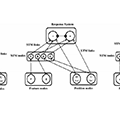Abstract
When up–down stimulus locations are mapped to left–right keypresses, an overall advantage for the up–right/down–left mapping is often obtained that varies as a function of response eccentricity. This orthogonal stimulus–response compatibility (SRC) effect also occurs when stimulus location is irrelevant, a phenomenon called the orthogonal Simon effect, and has been attributed to correspondence of stimulus and response code polarities. The Simon effect for horizontal stimulus–response (S–R) arrangements has been shown to be affected by short-term S–R associations established through the mapping used for a prior SRC task in which stimulus location was relevant. We examined whether such associations also transfer between orthogonal SRC and Simon tasks and whether correspondence of code polarities continues to contribute to performance in the Simon task. In Experiment 1, the orthogonal Simon effect was larger after practising with an up–right/down–left mapping of visual stimuli to responses than with the alternative mapping, for which the orthogonal Simon effect tended to reverse. Experiment 2 showed similar results when practice was with high (up) and low (down) pitch tones, though the influence of practice mapping was not as large as that in Experiment 1, implying that the short-term S–R associations acquired in practice are at least in part not modality specific. In Experiment 3, response eccentricity and practice mapping were shown to have separate influences on the orthogonal Simon effect, as expected if both code polarity and acquired S–R associations contribute to performance.
